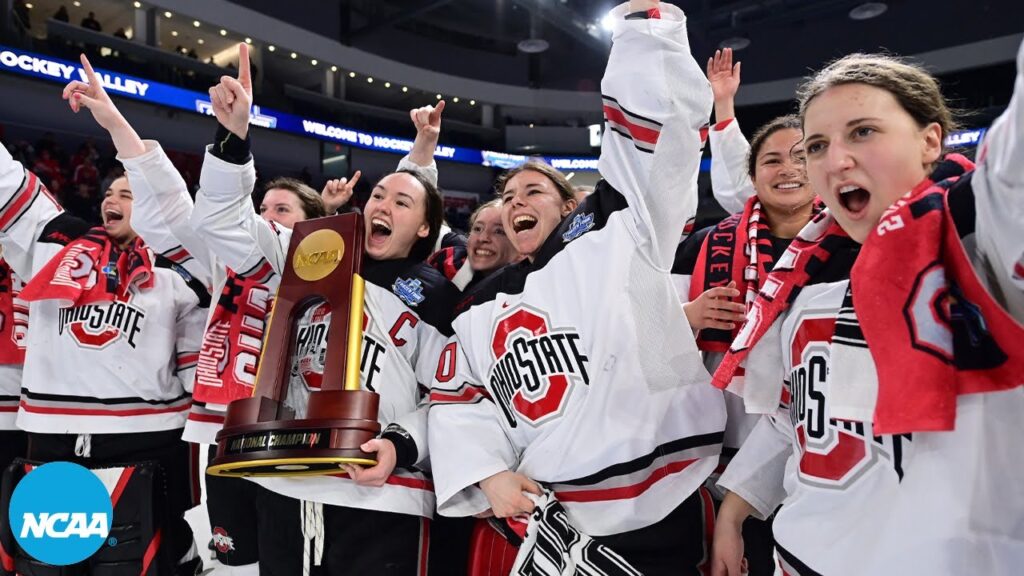Women’s hockey is more than just a sport; it’s a powerful movement that is breaking barriers and defying gender norms. With each stride on the ice, women athletes are paving the way for gender equality and empowering future generations.
The journey of women’s hockey can be traced back to the late 19th century, but it wasn’t until the 20th century that organized leagues and competitions began to emerge. The inclusion of women’s hockey in the Winter Olympics in 1998 marked a significant turning point, providing increased visibility and recognition for the sport.
Trailblazers like Hayley Wickenheiser and Cammi Granato have shown the world that women can excel in the sport just as skillfully as their male counterparts. However, women’s hockey still faces challenges such as unequal resources and pay disparities. Advocates and players are vocal about the need for investment and equitable opportunities to ensure the growth and success of women’s hockey.
Despite the challenges, women’s hockey continues to inspire young girls around the world, encouraging dreams and aspirations. The increase in youth participation speaks volumes about the influence these athletes have on future generations.
Professional women’s hockey leagues, such as the NWHL (National Women’s Hockey League) and PWHPA (Professional Women’s Hockey Players Association), are working to provide competitive platforms for elite athletes while also championing equal treatment and representation.
Women’s hockey represents more than just a game; it stands for gender equality, empowerment, and inclusivity. It’s a testament to the determination and resilience of women athletes who are breaking through ceilings and shattering stereotypes.
The future of women’s hockey looks bright with continued investment, support, and opportunities for players to shine. Together, with the unwavering passion of athletes, fans, and stakeholders, women’s hockey will continue to advance the game and inspire generations to come.
Key Takeaways:
- Women’s hockey is a powerful force, breaking barriers and defying gender norms.
- The inclusion of women’s hockey in the Winter Olympics in 1998 marked a significant turning point for the sport’s visibility and recognition.
- Trailblazing players like Hayley Wickenheiser and Cammi Granato have proven that women can excel in the sport.
- Women’s hockey still faces challenges such as unequal resources and pay disparities.
- Professional women’s hockey leagues advocate for equal treatment and representation.
A Historical Perspective
Women’s involvement in ice hockey can be traced back to the late 19th century, but it was during the 20th century that organized leagues and competitions began to emerge. This period in history marked a significant turning point for women’s hockey, as it sought to establish itself as a legitimate and competitive sport.
Despite societal norms and challenges, women demonstrated perseverance and determination, pushing the boundaries to pursue their passion for the game. The journey of women’s hockey in the 20th century was characterized by a gradual growth in recognition and support, paving the way for future generations of female athletes.
“Women’s hockey is a testament to the unwavering spirit of those who dared to challenge conventions and fight for their rightful place in the sport. Their resilience and dedication have paved the way for the flourishing women’s hockey we see today.”
During this period, organized leagues and competitions began to establish a framework for women’s hockey. Local and regional competitions provided an avenue for players to showcase their skills and foster a sense of camaraderie within the community. As the sport gained traction, it attracted a growing fan base and attracted attention from sponsors and supporters.
In parallel with the rise of organized leagues, advancements in technology and transportation enabled the expansion of women’s hockey competitions. Teams from different regions could now compete against each other, showcasing their talent and promoting the sport’s growth on a national and international scale.
Emerging Competitions in the 20th Century
| Year | Competition |
|---|---|
| 1920 | Women’s Metropolitan Hockey Association |
| 1933 | Women’s Western Hockey League |
| 1934 | Amateur Athletic Union Women’s National Championships |
| 1981 | International Ice Hockey Federation (IIHF) Women’s World Championship |
These competitions, along with others, laid the foundation for the continued development and recognition of women’s hockey. They not only provided a platform for players to showcase their skills but also contributed to the establishment of formalized rules, promoting fair play and competitive spirit.
As the sport progressed, women’s hockey in the 20th century witnessed significant milestones, setting the stage for the future. These milestones, combined with the dedication and passion of athletes, would shape the trajectory of women’s hockey and inspire generations to come.
Olympic Recognition

The inclusion of women’s hockey in the Winter Olympics in 1998 marked a significant turning point for the sport. With the global stage of the Winter Olympics, women athletes were given the opportunity to showcase their talents to a wide audience, increasing visibility and garnering recognition for the sport.
Being part of the Winter Olympics elevated women’s hockey to new heights, providing a platform for athletes to not only compete but also inspire future generations. The global recognition and exposure from the Olympics brought the sport into the spotlight, capturing the attention of sports fans worldwide.
Through the Winter Olympics, women’s hockey gained the visibility it deserved, breaking through barriers and challenging traditional gender roles in sports. The tournament became a stage for extraordinary displays of skill, commitment, and teamwork, captivating audiences and establishing women’s hockey as a force to be reckoned with.
“By embracing the Winter Olympics, women’s hockey has earned the recognition it rightfully deserves. It’s not just about the goals scored or the medals won but also about the journey, the perseverance, and the impact it has on the participants and spectators alike.”
The Winter Olympics provided an opportunity for women’s hockey to prove its worth, and the athletes seized the moment, delivering unforgettable performances and showcasing the depth of talent in the sport. The recognition received during the Olympics propelled women’s hockey into a new era, as stakeholders and fans alike recognized the power and potential of the game.
With each Olympic cycle, the visibility and recognition of women’s hockey continue to grow, inspiring young athletes and shaping the future of the sport. The Winter Olympics provided a platform for women athletes to demonstrate their skills, passion, and dedication, leaving a lasting impact on the hockey world.
Trailblazers and Icons

When it comes to women’s hockey, the names Hayley Wickenheiser, Cammi Granato, and Angela James resonate as trailblazers and icons. These remarkable athletes have left an indelible mark on the sport, proving that women possess exceptional skill and talent equal to their male counterparts.
Hayley Wickenheiser, a Canadian hockey player, not only dominated the ice but also shattered gender stereotypes throughout her career. With an impressive record that includes winning four Olympic gold medals and being the all-time leading scorer in Olympic women’s hockey, Wickenheiser’s dedication and proficiency have solidified her status as a true legend of the sport.
Cammi Granato, a prominent figure in American women’s hockey, played a pivotal role in popularizing the game and inspiring young players. As a member of the first-ever U.S. women’s Olympic hockey team in 1998, Granato led her team to a gold medal victory, showing the world what women are capable of achieving in the sport.
Angela James, known as the “Wayne Gretzky of women’s hockey,” was a driving force in shaping the game’s development. As the first woman to be inducted into the Hockey Hall of Fame and the recipient of numerous accolades, James showcased her exceptional skill and paved the way for future generations of female hockey players.
“Women’s hockey is not just a sport; it’s an opportunity for women to showcase their skill, passion, and dedication on a global stage. We have proven time and time again that we can compete at the highest level and excel in the face of adversity. Our success challenges the perceptions of what women can achieve in a traditionally male-dominated sport.”
These trailblazers and icons have not only elevated women’s hockey to new heights but have also inspired countless young girls to pursue their dreams and break through barriers. Their achievements serve as a testament to the immense skill and talent that women bring to the sport, proving that gender is not a limit but an opportunity for greatness.
| Athlete | Accomplishments |
|---|---|
| Hayley Wickenheiser |
|
| Cammi Granato |
|
| Angela James |
|
Challenges and Advocacy
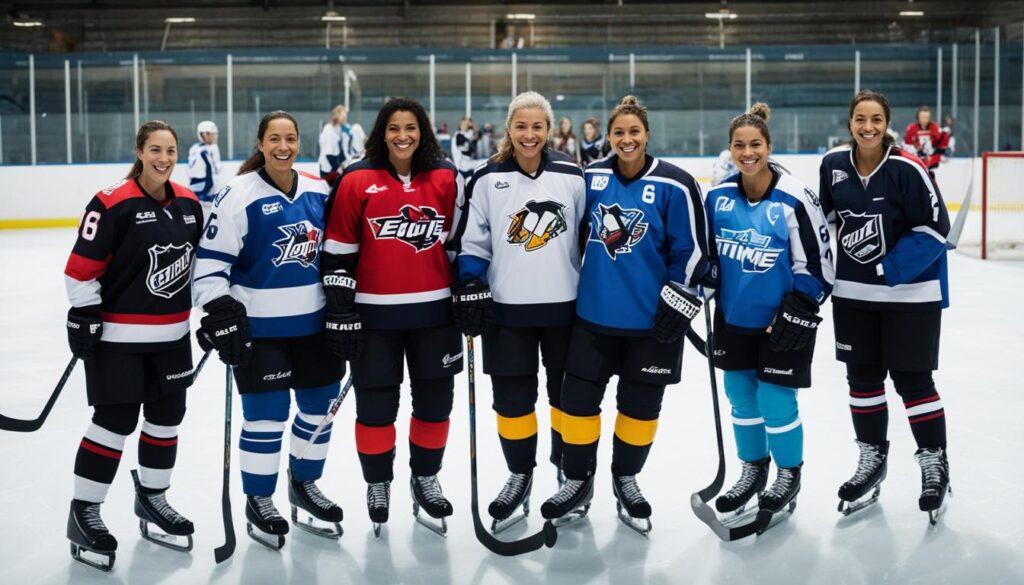
Despite the progress made in women’s hockey, the sport still faces significant challenges that hinder its growth and equality. Two key issues that persist are unequal resources and pay disparities. These factors not only affect the development of women’s hockey but also impede the overall advancement of female athletes in the sport.
Unequal resources in women’s hockey create a barrier to success. Without adequate funding, training facilities, coaching staff, and equipment, female players are at a disadvantage compared to their male counterparts. This disparity limits their ability to reach their full potential and compete on an equal playing field.
Pay disparities in women’s hockey perpetuate the cycle of inequality. Female players often earn significantly less than male players, despite showcasing the same level of skill and dedication. This discrepancy not only affects players’ livelihoods but also devalues their contributions to the sport.
Advocates and players are vocal about the need for investment, sponsorship, and equitable opportunities to address these challenges. Investment in women’s hockey would help bridge the resource gap, providing athletes with the necessary support and infrastructure to maximize their potential. Increased funding would lead to improved training programs, better facilities, and greater exposure, ultimately leveling the playing field.
Similarly, the establishment of equal pay structures and sponsorship opportunities is essential for fostering and sustaining the growth of women’s hockey. By ensuring equitable compensation for female players, the sport can attract top talent, promote professionalism, and encourage female athletes to pursue their dreams without financial barriers.
Advocacy for Change
“We need to invest in women’s hockey, offer the same resources and opportunities, and prioritize gender equality within the sport. It’s time to shift the narrative and create a future where women hockey players can thrive.” – Marie Philip-Poulin, Canadian Women’s Hockey Team Captain
Advocacy plays a crucial role in raising awareness of the challenges faced by women’s hockey and driving change. Players, coaches, fans, and organizations are calling for action to create a more equitable environment for female athletes.
Supporting Women’s Hockey
Investment, sponsorship, and equitable opportunities are vital to the future of women’s hockey. To ensure the growth and success of the sport, stakeholders must come together to:
- Allocate adequate funding to support women’s hockey programs, development, and infrastructure.
- Establish equal pay structures that recognize and value the contributions of female players.
- Provide sponsorship opportunities to enhance exposure, visibility, and financial stability.
- Promote gender equality within the sport, fostering an environment that embraces diversity and inclusivity.
| Challenge | Impact |
|---|---|
| Unequal resources | – Limited access to training facilities and equipment – Hinders skill development and competitive performance |
| Pay disparities | – Devalues female players’ contributions – Creates financial barriers and lack of professional opportunities |
Addressing these challenges and advocating for change are essential steps towards a more equitable future for women’s hockey. By investing in the sport and providing equal opportunities, we can empower female athletes to excel and inspire future generations.
Inspiring the Next Generation
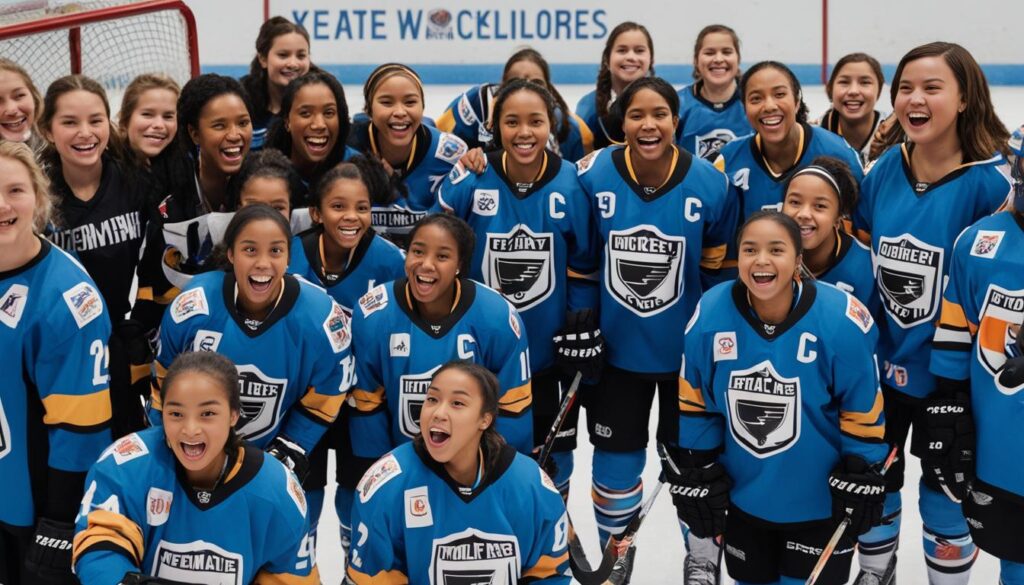
Today’s women’s hockey players are powerful role models, inspiring young girls around the world to dream big and pursue their aspirations. In a sport traditionally dominated by men, the success and achievements of women’s hockey players serve as a beacon of hope and proof that anything is possible. Witnessing women excel on the ice has a profound influence on the dreams and aspirations of future generations.
The rise in youth participation in women’s hockey is a testament to the impact these athletes have on young minds. By seeing women compete at the highest level, young girls are empowered to push boundaries, break stereotypes, and strive for greatness. The presence of strong female role models in the sport has the power to reshape societal norms, encouraging girls to pursue their passions fearlessly.
“When I see players like Hilary Knight and Kendall Coyne Schofield dominating on the ice, it motivates me to work harder and believe in myself. I know that I can achieve great things not just in hockey but in life too.” – Sarah, aspiring young hockey player
Through their skill, dedication, and perseverance, women’s hockey players demonstrate that gender is not a barrier to success. Their achievements inspire young girls to believe in their own abilities and pursue their dreams, whether it be on the ice or in any other field they choose.
The Impact of Youth Participation
The increase in youth participation in women’s hockey showcases the profound influence these athletes have on future generations. By inspiring young girls to take up the sport, women’s hockey players are not only creating a pipeline of talent but also shaping the future of the sport and breaking down barriers.
Engaging youth in the sport fosters a sense of camaraderie, empowerment, and personal growth. It teaches them essential life skills such as teamwork, discipline, and resilience while instilling a love for the game. By providing opportunities for young girls to participate in women’s hockey, we are investing in the future and empowering a generation of girls to realize their full potential.
Inspiring Dreams, Shaping Futures
The influence of women’s hockey extends far beyond the rink. It ignites the imagination of young girls, fueling their dreams and aspirations. Whether it be dreaming of representing their country in international competitions or breaking records on the world stage, these dreams are nurtured by witnessing the success of women hockey players.
Every time a young girl laces up her skates, she is taking a step towards her own journey of empowerment. The influence of women’s hockey on future generations is immeasurable, as it provides girls with the belief and motivation to create a future where gender equality and opportunity know no bounds.
| Benefits of Youth Participation in Women’s Hockey | Role Models Inspiring the Next Generation |
|---|---|
|
|
Building Professional Leagues
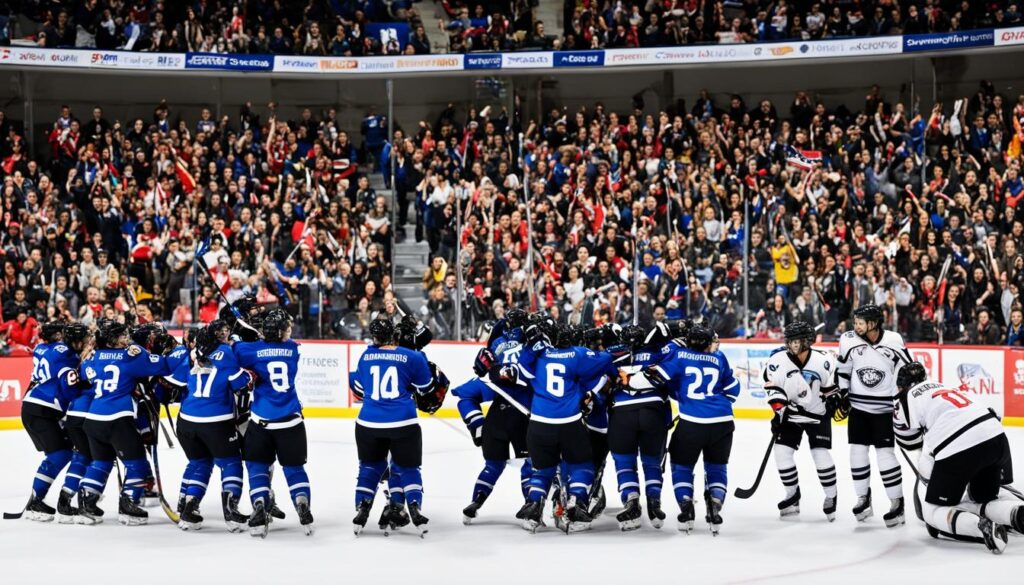
Professional women’s hockey leagues play a vital role in providing competitive platforms for elite athletes. Two prominent leagues, the NWHL (National Women’s Hockey League) and PWHPA (Professional Women’s Hockey Players Association), are revolutionizing the game and advocating for equal treatment and representation.
The NWHL, founded in 2015, comprises six teams and serves as a pioneering force in women’s professional hockey. It showcases the immense talent and skill of athletes from around the world, giving them a platform to shine. The league’s commitment to fostering inclusivity and gender equality has paved the way for a new era of women’s hockey.
On the other hand, the PWHPA, established in 2019, brings together players from various hockey backgrounds and unites them under the common goal of securing the future of women’s hockey. With a focus on providing competitive opportunities, the PWHPA organizes high-caliber events and showcases, further raising the profile of female athletes.
“The NWHL and PWHPA are crucial for the growth and development of women’s hockey. These leagues not only provide competitive platforms, but they also empower women, advocate for equal treatment, and represent the collective voice of female athletes. Their efforts are essential in progressing the sport and inspiring future generations of players.”
NWHL and PWHPA: A Comparative Overview
| League | Founded | Number of Teams | Mission |
|---|---|---|---|
| NWHL (National Women’s Hockey League) | 2015 | 6 | To provide a professional platform for women’s hockey and advance gender equality within the sport. |
| PWHPA (Professional Women’s Hockey Players Association) | 2019 | Independent association | To ensure that players have access to a viable, sustainable, and professional women’s hockey league. |
Both the NWHL and PWHPA actively collaborate with players, fans, and advocates to advocate for equal treatment, representation, and investment in women’s hockey. Their efforts are breaking down barriers and enabling more opportunities for female athletes to pursue their passion at the highest level.
As these leagues continue to grow and thrive, they inspire athletes and fans alike, creating a future where women’s hockey is recognized and celebrated on equal footing with its male counterpart.
Championing Gender Equality
Women’s hockey goes beyond the ice; it’s a symbol of gender equality and empowerment. Players, fans, and advocates are rallying to ensure that women’s hockey receives the recognition, investment, and respect it deserves, fostering a culture of inclusivity and fairness.
“We must continue to push for gender equality in sports. Women have proven time and time again that we are just as capable, dedicated, and skilled as our male counterparts. It’s important for society to recognize and celebrate our achievements in women’s hockey and provide us with the same opportunities and resources,” says Rebecca Johnston, a Canadian ice hockey player and Olympic gold medalist.
“Investment in women’s hockey is not only about fairness, but also about recognizing and nurturing talent. When we invest in women’s sports, we are investing in the potential of future generations, showing them that their dreams and aspirations matter. It’s about creating a level playing field where women can thrive,”
In recent years, there has been significant progress in promoting gender equality within the sport. The growth of women’s hockey leagues, such as the NWHL and PWHPA, highlights the importance of providing equal opportunities for women to compete at the professional level.
Fostering Inclusivity and Fairness
Creating a more inclusive and fair environment for women’s hockey involves addressing various aspects, including:
- Breaking down societal stereotypes and challenging gender norms
- Ensuring equal access to training facilities and resources
- Advocating for fair and equitable pay for women athletes
- Promoting gender diversity in coaching and leadership positions
- Encouraging sponsorship and media coverage for women’s hockey events
By championing gender equality in women’s hockey, we pave the way for progress and inspire future generations of athletes. It is through the collective efforts of players, fans, and stakeholders that we can truly empower women in sports and create lasting change.
The Future of Women’s Hockey
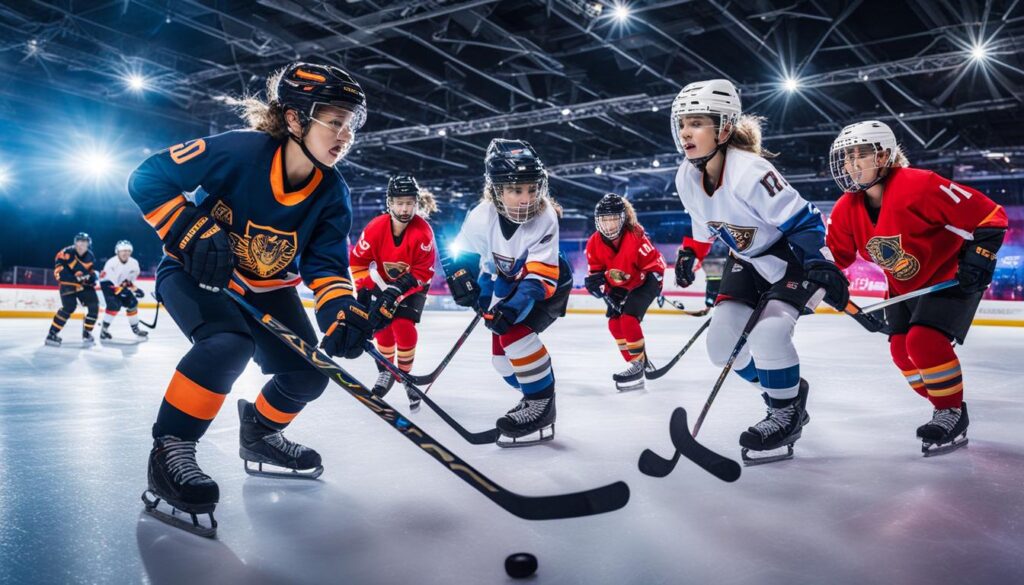
The future of women’s hockey holds immense promise and potential. With continued investment and support, the sport will witness unprecedented growth and opportunities for players to excel.
The dedication and passion displayed by athletes in women’s hockey is unmatched. Their relentless pursuit of excellence and love for the game serves as a driving force behind its continued evolution. As women’s hockey gains wider recognition and support, it will attract more talented individuals, resulting in a higher level of competition and greater overall quality.
“Investment and support are crucial as they provide the necessary resources and infrastructure for women’s hockey to flourish. It’s essential to create a sustainable ecosystem that nurtures talent and ensures equal opportunities for female athletes.” – Jane Thompson, President of Women’s Hockey Association
In addition to investment, the unwavering support of fans and stakeholders plays a pivotal role in shaping the future of women’s hockey. Their passion and advocacy help raise awareness, generate interest, and establish a strong foundation for the sport to thrive.
As the sport continues to gain momentum, more doors will open for women’s hockey at both the amateur and professional levels. Opportunities for international competitions, sponsorships, and media coverage will expand, further amplifying the sport’s reach and impact.
Key Trends and Initiatives
- Increased coverage and media visibility:
As media platforms recognize the significance of women’s hockey, more broadcasters and online outlets will provide dedicated coverage. This increased visibility will contribute to the growth of women’s hockey by attracting a broader fan base and sponsors. - Diverse talent pipelines:
Various grassroots programs and initiatives are actively promoting women’s hockey at the youth level. These programs enhance access and provide training pathways, ensuring a diverse talent pool for the future. - Partnerships and collaborations:
Collaboration among governing bodies, organizations, and brands fosters the development of women’s hockey. Such partnerships result in more comprehensive support systems, increased resources, and expanded promotional opportunities.
With investment, support, and a strong commitment from stakeholders, the future of women’s hockey is set to be a transformative one. The sport will continue to inspire countless individuals, breaking barriers and paving the way for future generations of athletes.
Also Read : Rent Gear Easily With Water Sports Equipment Rental Services
Conclusion
Women’s hockey is not simply a game on ice; it represents so much more. It breaks barriers, empowers athletes, and showcases the determination and resilience of women around the world. Through their unwavering passion and skill, women in hockey have shattered stereotypes and embraced diversity, proving that they are a force to be reckoned with on and off the ice.
As barriers continue to crumble, women’s hockey stands as a testament to the power of breaking through ceilings. Each stride taken by these courageous athletes advances the game and inspires future generations to dream big. Their journey inspires and empowers young girls, showing them what it means to be determined, resilient, and unafraid to pursue their dreams.
The future of women’s hockey is bright, fueled by the empowerment and dedication of athletes, advocates, and fans. With each victory and accomplishment, the sport gains more recognition and support. Women’s hockey is not just about goals and assists; it represents empowerment, breaking barriers, and a commitment to creating a more equal and inclusive world for the future generations of athletes to come.
FAQs
Q: When was the league announced?
A: The league was announced on September 7, 2022.
Q: How many regular season games are played in a season?
A: The regular season typically consists of 24 games for each team.
Q: What is the significance of the 2024 season?
A: The 2024 season marked a pivotal moment in the league’s history, showcasing the growth and progress of women’s hockey.
Q: Where can I find the league’s season schedule?
A: The league’s season schedule is available on their official website and can also be accessed through their official social media channels.
Q: Which team emerged as the champion in the last season’s championship?
A: The Minnesota Superior team clinched the championship title in the previous season.
Q: Is there any external link that provides detailed information about the league’s history?
A: Yes, you can find extensive information about the league’s history on its Wikipedia page.
Q: When did the inaugural game of the league take place?
A: The inaugural game of the league took place on August 29, 2022.
Q: Can you provide details about the franchise expansion and the addition of new teams?
A: The league announced the addition of new franchises and teams, expanding its reach and creating more opportunities for players and fans.
Q: What are the key milestones achieved by the league since its inception?
A: Since its inception, the league has achieved several milestones, including the first overall pick, debut games, and remarkable performances by various teams.
